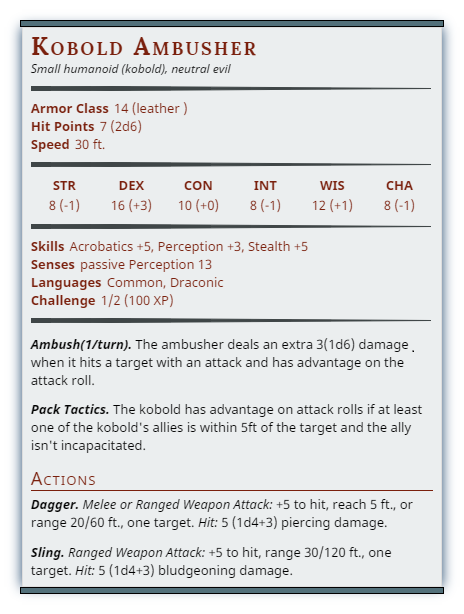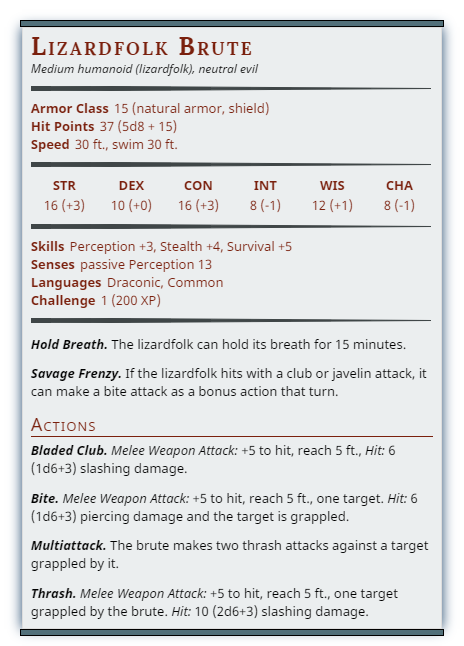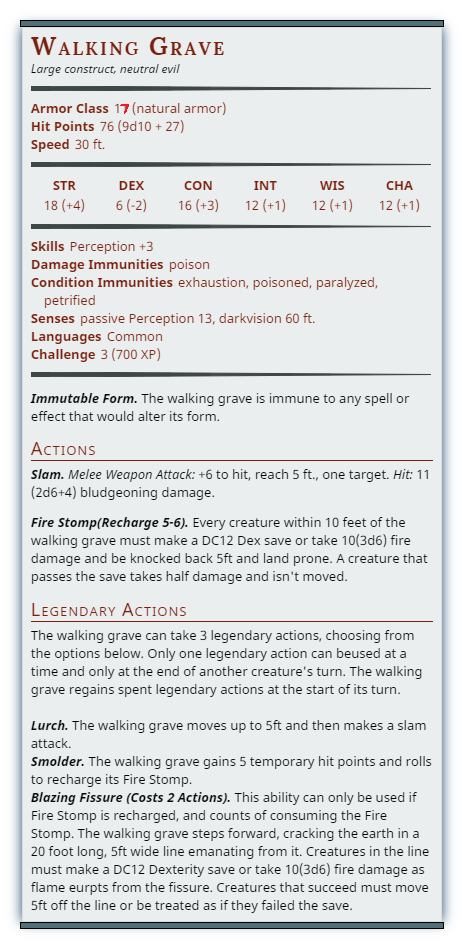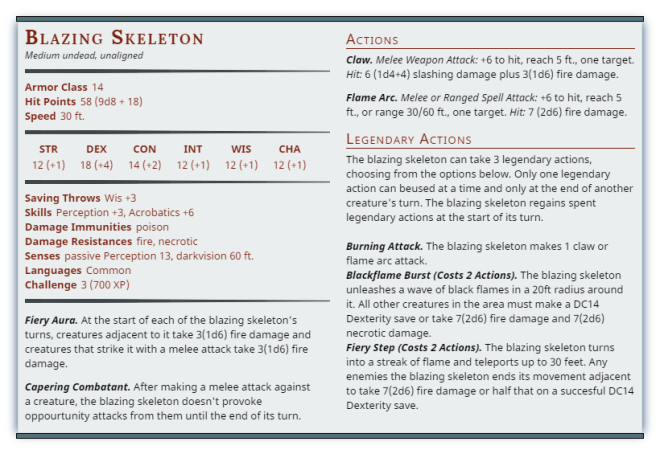So if you’re anything like me, you’re always looking for more enemies to throw into the monster-thresher that is your group of PCs. The Monster Manual is a great source for this, as are the stats found in other published supplements such as official adventures or homebrew stuff. But even with the hundreds and hundreds of monsters available for your selection, sometimes you’ll want to go the extra mile and come up with exactly the right bundle of numbers and abilities to represent the nasty thing you have in mind. In that case, you have three primary options: tweaking an existing statblock, converting something from another edition or game, or creating something fresh. I’ll provide examples of each of these, and hopefully provide a decent explanation of the reasoning behind both thematic and mechanical changes.
PS: Credit for teaching 5E GMs how to build monster good goes to The Angry GM’s series of articles: The Monster Lab. This article either wouldn’t exist or would be much worse without him.
PPS: The program I used for the statblocks is the D&D Monster Maker.
Option 1: Tweaking
If the enemy you want to make is something that could be described as “like a [Monster Manual entry] but…” then this is probably your best option. So, to jump right in, say your level 3 PCs are going to be dealing with some kobolds that live in a swamp. You want to: A) Make kobolds that seem adapted to fit in a swamp environment and not an underground one, and B) Make kobolds that are actually a challenge to level 3 PCs, a little more formidable than the default CR 1/8 option. Because 10 or 11 vanilla kobolds, while an ostensibly balanced encounter for 4 level 3 characters when you account for the encounter multiplier for number of monsters, is going to be boring for you and the players. You want to make a small palette of suitable swamp kobolds that you can mix and match to create interesting encounters. First, let’s start with the general traits that all of these swamp kobolds have, before we get too specific. If you want to tweak a whole category/species of monsters, I recommend starting with with the shared traits like this. Since the swamp kobolds don’t live underground, they’ll lose both their darkvision and their Sunlight Sensitivity. They should also be semi-aquatic to facilitate getting around their swampy home. So, we’ll transplant some lizardfolk DNA and give these kobolds Hold Breath and a 30ft swim speed like their big lizard cousins. Do we need to add anything else to our “swamp kobold” template? Well, I see these guys as being a bit more of the survivalist type than our standard kobolds, and probably a bit more hardy to deal with all those nasty diseases in that bog water they’re swimming in. So, we’ll increase their Constitution scores from 9 to 10, their Wisdom scores from 7 all the way up to 12, and give them proficiency in Perception and Survival to boot. And with that, we’re done with our default swamp kobold. It sounds like a lot of work, but it really only takes about 5 minutes of thinking, starting with a general theme and using the game mechanics to narrow down our idea. You can pretty much do this kind of thing with any enemy. Underdark bugbears? 30ft of blindsight and the ability to cast darkness 1/day. Demons from a Stygian ice realm? Replace any instance of fire with cold and give their attacks 10ft of slowing like ray of frost. I could go on, but I’m sure you get the idea.
But while templates are nice and all, it doesn’t solve our vanilla problem. Let’s narrow down and make a specific enemy for our swamp kobold tribe. The concept I have in mind is a “Kobold Ambusher,” something that can surprise our PCs and slink around the edge of the battlefield, taking advantage of weak points and distractions. Hey, “advantage.” Let’s make a kobold that synergizes with their preexisting feature, Pack Tactics, which gives them advantage on attack rolls if their target is within 5 feet of an ally. Some kind of sneak attack sounds like a good option. That ability reads:
Sneak Attack(1/turn): The [monster] deals an extra [X] (Xd6) damage when it hits a target with a weapon attack and has advantage on the attack roll, or when the target is within 5 feet of an ally of the [monster] that isn’t incapacitated and the [monster] doesn’t have disadvantage on the attack roll.
Since kobolds will already have advantage on attack rolls if their target is within 5 feet of an ally, we can shave off that whole last bit and only give the bonus damage if they have advantage on their attack roll. We’ll probably want to keep the damage fairly low, since these are still just kobolds. Let’s call it 1d6. So, our pseudo-Sneak Attack is now:
Ambush(1/turn): The kobold ambusher deals an extra 3(1d6) damage when it hits a target with a weapon attack and has advantage on the attack roll.
With that simple change, we’ve made our kobold ambusher much more interesting than a vanilla monster. Their attacks will now be accurate, because of advantage, and more damaging because of the bonus 1d6. They’re good in a skirmish where they can slink around the edge of the fight and attack engaged PCs from a range, or, fittingly, in an ambush, where they gain advantage for attacking from surprise. Tactically-minded PCs will be looking for ways to negate their Pack Tactics in straight fights, and likely be wary of these kobolds lying in wait below the water and concealed behind dense swamp foliage. Our last simple changes will be to raise our kobold’s Dexterity from 15 to 16 for the extra 1 point of modifier to make them more effective in combat, and give them some leather armor, likely made from skin and scales of the beasts of the swamp that they hunt. We calculate the new CR(I again recommend The Angry GM’s excellent series of articles on 5E monster building for this), and our final statblock looks like this:

Option 2: Converting
So, maybe just tweaking a statline doesn’t do it for you. You want to make something more interesting than just cobbling together different bits and bobs from a variety of monsters. In that case, you can always try swapping over stats from a different game. It sounds a little out there, but I find that the mental exercise of switching between rulesets often inspires me to think about the monster in a more interesting way. This is something that sort of requires having an extensive library of bestiaries from different games, but I recommend having a big RPG library anyway – especially with the advent of cheap digital books.
Let’s provide an example. Building on our swamp kobolds, let’s make some melee allies that can give them that juicy damage bonus from Pack Tactics. I mentioned lizardfolk earlier, and I like the idea of lizardfolk and kobolds working together as part of one swamp tribe. Now, the default lizardman in the Monster Manual is fine, but it’s kind of boring – all it does is make two basic attacks every round with a different weapon. Let’s convert a new lizardman enemy, using a statline from a different game as our inspiration – the “Lizardman Savage” found in the 13th Age rulebook. That enemy can follow up a successful weapon attack with a bite attack, and the round after it can perform a damaging “ripping frenzy”(which I think was designed to evoke an alligator’s death roll – understanding the themes of the to-be-converted statline can often help with the translation). So we’ll convert that new set of actions to the 5E rules, and use the default lizardfolk stats as our baseline. This does involve some tweaking, but the focus of this enemy is the bite & frenzy combo, making it more of a conversion than a tweak(My blog, my rules). We’ll give this lizardfolk more Strength, Constitution, and HP – my mental image of this enemy is a hulking brute. We’ll start with the ability to chain a bite from a successful melee attack:
Savage Frenzy: If the brute hits with a successful melee weapon attack, it can make a bite attack as a bonus action.
We’ll add the grappled condition to the damage inflicted by a bite, and knock the damage down a little bit to compensate. Then, we’ll add our “death roll”, which I see as this lizardfolk tearing into the poor grappled PC with a combination of jaws and weaponry. We’ll say that’s a multiattack with an extra damage die over its default weapon attack. After calculating its CR, our final monster looks like this. Hopefully the adventurers fighting it learn to get out of its jaws before its too late!

Option 3: Creating
Sometimes, the two options above just don’t cut it. Your imagination runs wild and you end up with an idea for a monster so out there that it really demands its own statblock. In this case, you can still pick select elements from preexisting monsters, but your new creation will still need to involve much more of your own brain products than the prior two methods. In my opinion, this is the most fun kind of monster to make, but it’s understandably also the longest, most involved type. A lot of the time, a simple tweak will get what you need to convey across, but if you’re making something unique to your campaign you’ll have to start from scratch.
Let’s get into an example, a modified version of something I used in my own game. The concept is “sentient flaming skeleton trapped in a tomb-cage of stone and iron that it can steer around like a giant undead-construct mecha before breaking out once it takes enough damage.” Maybe not the most elegant description, but it is metal as hell, and a two-phase boss fight is generally something both GMs and players enjoy. We’re designing this as a hard fight for level 3 PCs, so we’ll do two CR3 monsters to be fought back to back, and we’re going to throw in some legendary actions to make the fight more dynamic. Let’s start with the first phase, the construct being piloted. It’s going to have a decent AC* and number of hit points, as befitting something mostly made of rock, high Strength and Constitution, and poor Dexterity. However, it’s going to have decent mental scores, unlike most constructs, since the intelligent undead skeleton inside it is the brain, and a corresponding lack of some of the usual construct immunities. Even with legendary actions, this thing just making melee attacks will be dull, so we’ll give it an AoE stomp: the blazing skeleton inside releasing a wave of fire around it. For legendary actions, we’ll give it a brief move into a slam attack, another fire-related move that taps into the same recharge pool as the stomp, and the ability to gain a little health and the chance to recharge its special moves. We’ll make that last one a temporary HP gain, since temp HP doesn’t stack and that way it won’t be able to use the same ability for all 3 legendary actions. Oh, and the “Immutable Form” feature that all golems have, since this is essentially a golem controlled by a sentient undead instead of an elemental. Our first phase looks like this:

*The AC is supposed to be 17. I mistakenly saved the image file with AC11 and forgot to save the actual Monster Builder file. Always save your work.
Looks good to me. Once the skeleton inside breaks out, I want the dynamic of the fight to change – our blazing skeleton should be a very mobile combatant with a threatening fire aura. It should be able to throw out a lot of damaging fire attacks and deal a lot of AoE and chip damage to all the enemy adventurers, but be correspondingly fragile. We’ll give it a damage aura, the ability to ignore opportunity attacks from enemies it attacks, basic ranged and melee options, and legendary teleporting and big AoE attacks. Our final stats:

And that’s our custom boss done, except for the warning label that says “Bring potions of fire resist”. Har har.
So now that I’ve shown you the 3 ways you can make a unique D&D 5E monster, I hope you can go forth and create something yourself. Feel free to use any of the monsters in this article in your game(as long as you tell me how it goes), and stay tuned for more posts.